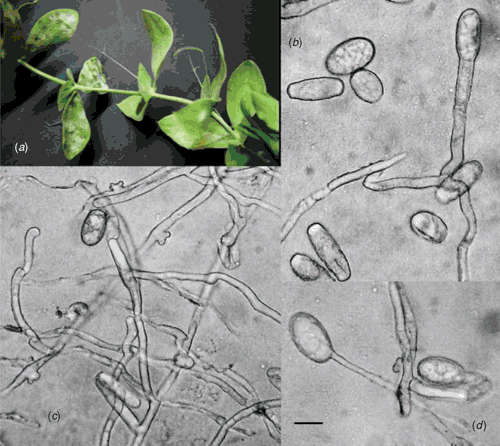First record of powdery mildew caused by Oidium sp. (Erysiphaceae) on Eustoma grandiflorum in Argentina
M. G. Cabrera A C , G. Vobis B and R. Alvarez AA Universidad Nacional del Nordeste (UNNE), (Department of Plant Protection) Facultad de Ciencias Agrarias. Sargento Cabral 2131. CP 3400, Corrientes, Argentina.
B Universidad Nacional del Comahue, Centro Regional Universitario Bariloche, Quintral 1250. CP 8400, San Carlos de Bariloche, Río Negro, Argentina.
C Corresponding author. Email: cabrera@agr.unne.edu.ar
Australasian Plant Disease Notes 4(1) 37-38 https://doi.org/10.1071/DN09015
Submitted: 9 March 2009 Accepted: 28 March 2009 Published: 15 April 2009
Abstract
In 2008, a powdery mildew on Eustoma grandiflorum collected in Corrientes, Argentina was determined to belong to Oidium subgenus Pseudoidium. The diagnostic features of the anamorph were recorded, but the teleomorphic state of this fungus was not found. This is the first report of Oidium subgenus Pseudoidium affecting E. grandiflorum in Argentina.
Eustoma grandiflorum, prairie gentian or ‘lisianthus’, is native to the plains states in the USA, and it was introduced to Argentina as a cut flower in the 1990s. It is an annual or biennial plant belonging to the family Gentianaceae and is commonly grown as an ornamental plant in Argentina.
We found diseased plants of E. grandiflorum in the Campus of Facultad de Ciencias Agrarias, in Corrientes, (north-east Argentina), in October 2008. The samples collected were found to be heavily infected by a powdery mildew. Disease symptoms included chlorosis and white, powdery efflorescences on leaves and stem of plants.
Powdery mildew disease on E. grandiflorum was reported in California (USA), Brazil and Argentina. The pathogen was identified as Leveillula taurica Lev. Arnaud in the USA (Koike et al. 1995), Sphaerotheca sp. in Brazil (Amano 1986), and Oidium subgenus Pseudoidium in Japan (Okamoto et al. 2002). Pathogenicity was confirmed through inoculations by gently pressing diseased leaves onto leaves of healthy E. grandiflorum plants. Three plants were inoculated. Three non-inoculated plants were used as controls. Plants were maintained in a greenhouse at temperatures ranging from 20°C to 26°C. Seven days after inoculation, typical symptoms of powdery mildew developed on inoculated plants. Non-inoculated plants resulted as asymptomatic. The pathogenicity test was carried out twice. Microscopic examination showed conidiophores of an Oidium subgenus Pseudoidium type (Fig. 1b). The teleomorph was not found on the plants.

|
The mycelia were amphigenous with lobed appresoria (Fig. 1c). Hyphae were sub-straight to flexuous. The conidiophores were formed singly or occasionally in pairs on a hyphal cell. They were straight, erect (55) –70 (–75) × 7–9 µm. The foot-cells were short, 20–25 × 10 µm, cylindrical, and they were followed by two cells, one longer than the foot cell and the other of nearly the same length. The basal septum was located at the branching point of the mycelium. Conidia were borne singly, ellipsoid-cylindrical to doliform, 25 (–30) –37.5 × 17.5 (–19) –22.5 µm, without conspicuous fibrosin bodies (Fig. 1b). The germ tubes terminated in lobed appresoria (polygony type) (Fig. 1d). These characters all indicated that this fungus belongs to the genus Oidium subgenus Pseudoidium, which is used as a subgenus for the anamorphs of Erysiphe (sections Erysiphe, Microsphaera and Uncinula) that have single conidia without fibrosin bodies (Braun and Takamatsu 2000). This is the first report of Oidium subgenus Pseudoidium affecting Eustoma grandiflorum in Argentina.
Braun U, Takamatsu S
(2000) Phylogeny of Erysiphe, Microsphaera, Uncinula (Erysipheae) and Cystotheca, Podosphaera, Sphaerotheca (Cystotheceae) inferred from rDNA ITS sequences – some taxonomic consequences. Schlechtendalia 4, 1–33.

Koike ST,
Tjosvold SA, Greene ID
(1995) Powdery Mildew of Eustoma caused by Leveillula taurica in California. Plant Disease 78, 1219.

Okamoto J,
Limkaisang S,
Nojima H, Takamatsu S
(2002) Powdery mildew of prairie gentian: characteristics, molecular phylogeny and pathogenicity. Journal of General Plant Pathology 68, 200–207.
| Crossref | GoogleScholarGoogle Scholar |
CAS |



